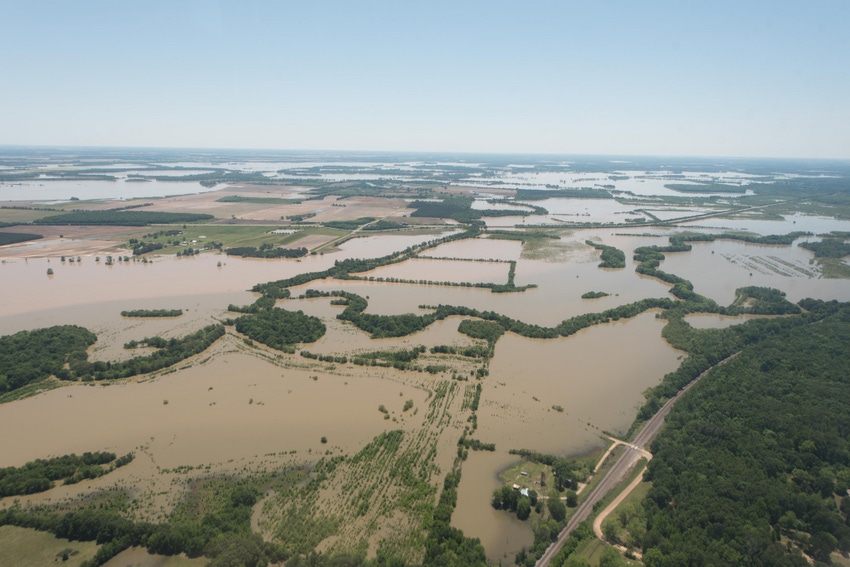Rice crop hardest hit as 89% had been planted.

With flooding and other storm effects battering some 937,000 acres of Arkansas cropland, losses to farmers could hit $64.5 million, according to a preliminary estimate released by the University of Arkansas System Division of Agriculture. Many growers and agricultural industry experts are still waiting to learn what can be salvaged of the remaining planting season.
"If those numbers scare you, you should be terrified," said Jarrod Hardke, extension rice agronomist for the University of Arkansas System Division of Agriculture. "I'm being conservative. There's no sugar-coating it."
The weather has struck Arkansas agriculture with some heavy blows in the last decade, with row-crop farmers suffering an estimated $40-50 million loss last year due to heavy rain, beef cattle producers enduring a $128 million loss from drought in 2012 and farmers hit with an estimated $335 million in losses in 2011 from flooding that mirrored the scale of this year's floods.
Hardke compiled the estimate from a survey of extension agents and agronomists. Among the factors taken into account: the costs of seed and herbicides already applied, equipment and labor. It did not include the impact of the flooding and high winds to poultry facilities in the northeastern part of the state or farm structures, grain or feed storage or other structures.
Still, there was a glimmer of hope: Of the 937,000 affected acres, the crops on 641,300 acres were expected to survive - if no more rain falls. Of the crops affected, rice was the hardest hit. Eighty-nine percent of the state's anticipated 1.2 million-acre rice crop had been planted, according to a National Agricultural Statistics Service (NASS) report, and 71% of planted rice had emerged.
"I'm estimating 156,000 acres of rice were lost," Hardke said. "I don't mean prevented planting; I mean acres lost that have already been planted."
Soybean losses were pegged at 83,200 acres, corn at 47,900 acres and cotton at 9,300 acres.
Soybean area was projected to be 3.5 million acres this year, with 45% planted and 32% emerged. Of the projected 600,000 acres of corn, 97% were planted and 89% emerged. Cotton, projected to total 500,000 acres, was 15% planted and 5% emerged.
Jeremy Ross, extension soybean agronomist with the University of Arkansas System Division of Agriculture, said soybeans are likely the crop least affected by flooding in the state, simply because the disaster occurred so early in the planting window for soybeans.
“A lot of the seed is still in the bag, and overall availability is just fine,” Ross said. "Growers looking to replant may not get their first choice of varieties, but they should be able to find seed to plant.”
Nonetheless, Hardke said anything that's still covered in water at the end of this week will be a complete loss. Farmers need to make preparations for that crop to be gone and be ready to take action whenever it dries, he added. If the wetness remains, it could be June before it will be dry enough to replant.
Hardke said many will face a definitive “fork in the road” as soon as they can truly eye their soil.
“Each field that comes out from under the flood is going to be a new adventure — every single one,” Hardke said. “Some of them may be okay. Some of them, there’s going to be a huge amount of debris left. Others, there will be less soil than they started with.”
Hardke said some producers who weathered the 2011 floods were lucky enough to have a good survival rate in their rice.
"Those are the exceptions," he said. "It depends on the temperature of the air, the water temperature, whether the water is muddy or clear or moving or stagnant."
One positive is that temperatures had been relatively cool.
"Being cool, it's good," Hardke aid. "If the water gets warm and stagnant, you're going to see that crop go out a lot faster."
The April 28-30 storms spawned tornadoes in Boone, Drew, White, Woodruff and Lonoke counties. Some areas in Arkansas saw more than 10 in. of rain during the weekend, prompting flash-flood warnings across the state.
About the Author(s)
You May Also Like



